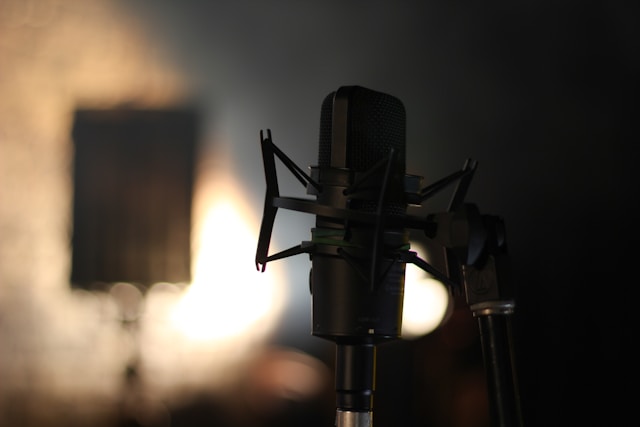What is Dubbing? The Definition, Process and New Methods

Dubbing is why a Korean thriller can hook a viewer in São Paulo, or a product demo recorded in English can land with customers in Tokyo. In short, dubbing replaces (or layers over) original speech with a new performance—often in another language—so audiences experience content naturally in their own tongue. This first half covers what dubbing is, why it matters now, and the main types you’ll encounter.
What Dubbing Is (and Isn’t)

Dubbing is the craft of recording new voice performances to replace or overlay original dialogue. Most often it’s a translation into another language, but teams also dub in the same language to fix noisy lines or sharpen performance.
How it differs from nearby terms:
- Subtitles: On‑screen text. Fast and cost‑effective, but they require reading and can dilute immersion.
- ADR (Automated Dialogue Replacement): Re‑recording lines in the same language to improve clarity or performance.
- Voice‑over: A style of dubbing (common in docs/news) where the translated voice sits on top of the original, which stays faintly audible.
Tiny example
Original: “We have to move now!”
Dub (ES): “¡Tenemos que movernos ya!”
The goal isn’t literal, word‑for‑word substitution. It’s equivalence of effect: timing, tone, and meaning that land the same way for a new audience.
Why Dubbing Matters Today
The old model—ship one version, add captions—doesn’t match how people discover and binge content now. Dubbing meets three modern realities:
- Global discovery: Streaming catalogs, social platforms, MOOCs, and app stores are borderless. Native‑language audio helps your story, lesson, or product demo travel farther, faster.
- Engagement & accessibility: Hearing a message in your own language reduces cognitive load, especially for kids, multitaskers, and viewers with reading or vision challenges.
- Brand trust & conversion: Marketing and product videos perform better when they “sound local.” The same applies to support and training content inside global companies.
And for live content—webinars, keynotes, podcasts, creator streams—live dubbing (real‑time translation + synthetic or selected voices) turns one talk into many local-language feeds at once. We’ll break this down in Part 2.
Case Study: How “La Casa de Papel” Proved the Power of Dubbing

When La Casa de Papel—known globally as Money Heist—first aired on Spanish television, it drew modest ratings. But when Netflix picked it up, translated, and dubbed it into English, French, and over 30 other languages, the show exploded into a worldwide sensation.
The English dub wasn’t just a translation—it was a re-performance. The voice team captured Professor’s calm intellect, Tokyo’s impulsive energy, and Berlin’s theatrical menace with precision. Each localized version adapted idioms, timing, and even cultural references so lines landed naturally.
By the time Season 3 launched, Money Heist had become the most-watched non-English series in Netflix history at that point—an outcome impossible without high-quality dubbing. The series proved that language barriers are no longer creative barriers; strong dubbing can carry a story’s emotion and rhythm anywhere in the world.
The Main Types of Dubbing

1) Lip‑Sync Dubbing
The gold standard for narrative film/TV. The adapted line must match mouth shapes, syllable counts, breaths, and emotional beats. It is doable using AI technology to synchronise the lip movements of actors without all the manual work. Try Maestra's AI lip sync generator now!
- Micro example
Original: “I’ll be back.”
Dub (IT): “Tornerò.”—short, punchy, and rhythmically tight.
When to use: scripted stories, premium brand films, character‑driven videos.
Watch‑outs: Some languages expand/contract on translation. Skilled adapters reshape lines without losing meaning.
2) Voice‑Over Dubbing
The translated track plays over a low‑volume original. It’s efficient, intelligible, and widely used for interviews, explainers, and non‑fiction.
- Micro example
Original (quiet underlay): “I started this project in 2018.”
Voice‑over (FR): “J’ai commencé ce projet en 2018.”
When to use: documentaries, testimonials, news packages, knowledge content.
3) ADR (Same‑Language Replacement)
Technically a form of dubbing. Actors re‑record lines to fix noise, adjust performance, or align with last‑minute script changes.
When to use: location sound problems, continuity fixes, or to sharpen delivery in product walkthroughs and ads.
4) Narration / Descriptive Dubbing
A narrator guides viewers through visuals—ideal for tutorials, e‑learning, or product education. Sync is less about lips and more about on‑screen beats.
When to use: long‑form instruction, onboarding flows, documentary overviews.
5) Live Dubbing (Real‑Time) — Preview
Real‑time translation and voice rendering while someone speaks. Think webinars, conferences, live broadcasts, and multilingual customer support. A typical pipeline looks like: speech recognition → machine translation → voice generation → audience output. In Part 2, we’ll unpack latency, terminology handling, and practical setup tips.
6) Voice Cloning Dubbing
AI-powered voice cloning allows creators to generate or replicate natural-sounding voices in different languages while keeping the same tone, style, and personality as the original speaker. This new form of dubbing preserves emotional authenticity—so the audience still feels the speaker’s real intent, even when the words change. And it is easy to achieve using an AI-powered voice cloning tool.
How Dubbing Works (Traditional Workflow) — Setup Steps

We’ll dive deeper in Part 2, but here’s the front half of the workflow:
1) Translation & Adaptation
Translators localize idioms, humor, and cultural references. Adapters then shape timing and syllable counts for sync.
- Example of adaptation at work:
A pun that won’t travel gets swapped for a culturally equivalent joke that triggers the same laugh.
2) Casting & Direction
Voices are chosen for timbre, age, energy, and character fit. A director keeps performances aligned with the original’s intent—stakes, subtext, and pacing.
3) Recording to Picture
Actors record while watching the scene, hitting “in/out” points and breaths. Precision matters—especially for lip‑sync.
4) Editing & Mix
Editors assemble the best takes, tighten sync, and clean breaths or mouth noises. Mix engineers then balance the dub against the music‑and‑effects (M&E) stem so nothing feels “pasted on.” Watch levels (platform loudness targets vary), preserve spatial cues (reverb/room tone), and make sure key SFX—doors, footsteps, UI clicks—still read under dialogue.
- Micro tip: If a character turns their head mid‑line, a subtle pan or reverb tweak helps the dub feel like it lives in the same space as the picture.
5) Quality Control
Final reviewers check:
- Sync: Do plosives and closures (“p,” “b,” “m”) line up with the mouth?
- Continuity: Do names, product terms, and catchphrases stay consistent across episodes/assets?
- Clarity: Any masking with score or SFX?
- Cultural fit: Is the adapted joke/reference appropriate for the locale?
Live Dubbing, Deep Dive
What it is: Real‑time translation and voice rendering while someone speaks—ideal for webinars, conferences, streams, and multilingual support.
How it works (simplified pipeline):
Live audio in → 2) speech recognition → 3) machine translation → 4) voice generation (synthetic or selected voices) → 5) audience output.
Platforms like Maestra bundle these steps so hosts don’t juggle multiple apps, making setup and monitoring simpler during a live moment.
Where it shines:
- Global keynotes, launches, and AMAs
- Creator streams with multinational audiences
- Customer training and onboarding sessions
- Community calls and town halls
What to prepare:
- Languages & audience priority: Start with 1–3 core locales.
- Glossary & style notes: Product names, acronyms, preferred tone (formal/informal), and disallowed terms.
- Name pronunciations: Speaker bios, place names, brand names.
- Audio path: Good mic hygiene, stable network, clean room tone.
- Roles: A presenter, a technical monitor, and an operator to watch levels/feeds.
Latency & expectations: Real‑time systems inevitably introduce delay in the low‑seconds range. For Q&A, repeat audience questions and add brief pauses so translated audio can keep up. If you’re showing time‑sensitive visuals (demo clicks), narrate actions a beat in advance.
Run‑of‑show checklist:
- Before: Rehearse once end‑to‑end. Load glossary. Test mic, network, and recording. Decide where translated audio will play (stream track vs. breakout).
- During: Announce language options at the start. Monitor levels. If a term isn’t translating well, swap to a simpler synonym.
- After: Save original and localized tracks separately for later editing. Gather chat feedback by locale. Note terms to add to the glossary.
Quick example (live, customer webinar)
Original: “Click Export to generate your monthly report.”
Live dub (ES): “Haga clic en Exportar para generar su informe mensual.”
Clear, on‑brand, and synced to the moment the host clicks.
Dubbing vs. Subtitles (Expanded)
Choose an AI dubbing tool when you need:
- Immersion & emotion: Performance carries meaning (narrative, brand films).
- Accessibility: Great for kids, multitaskers, or viewers with reading challenges.
- Higher conversion: Product and ad content that must sound local.
Choose subtitles when you need:
- Speed & cost efficiency: Fast localization for long catalogs.
- Niche languages: Low‑volume markets where a full dub isn’t viable yet.
- Technical content: Viewers may prefer reading precise terms.
Pragmatic approach: Launch with subtitles (using an auto subtitle generator) to test demand; dub top performers for priority locales.
Common Challenges—and Practical Fixes
- Lip mismatch: Allow adapters to reshape lines; don’t force literal translations.
- Flat delivery: Provide actor notes, stakes, and reference clips. Record quick alternates.
- Terminology drift: Lock a living glossary; assign a language lead to enforce it.
- Audio clutter: Always mix against M&E; carve a small EQ pocket for dialogue if needed.
- Live surprises: Build a plan B—backup mic, wired connection, and a simple fallback phrasing for tricky terms.
Micro example (humor adaptation)
Original (pun): “That’s nacho average snack.”
Dub (PT‑BR): “Esse lanche não é nada comum.” (Drops the pun, keeps the playful tone.)
The Near Future: AI Dubbing, Thoughtfully Used
AI now accelerates every stage—transcription, translation, timing, and voice generation—bringing professional‑sounding localization within reach of lean teams. The winning pattern is hybrid: automation for speed and scale; humans for intent, sensitivity, and final polish. Expect better speaker separation in group audio, more consistent voices across languages, and faster turnarounds for episodic content. Solutions like Maestra lean into this hybrid model so teams keep creative control while shipping faster.
Iconic cadence, new language
Original: “May the Force be with you.”
Dub (FR): “Que la Force soit avec toi.”
Same beat, same feeling—what good dubbing aims for.
Conclusion
- Dubbing isn’t just translation—it’s performance, timing, and culture working in sync.
- Live dubbing turns one voice into many, in real time. Prepare a glossary, rehearse, and set expectations on latency.
- Start with subtitles, dub what proves traction, and maintain a glossary/style guide to protect quality.
- Use AI + human review to scale without losing intent.
- Keep post‑production strong: edit, mix, and QC make the difference between “fine” and “feels native.”
FAQ
What’s the difference between dubbing and voice-over?
Voice-over keeps the original audio faintly in the background while the translation plays over it. Dubbing replaces the original dialogue entirely and syncs it to the speaker’s lips and timing.
Is dubbing better than subtitles?
Neither is universally better. Dubbing improves immersion and accessibility, while subtitles are cheaper and faster to produce. Many creators start with subtitles and later dub their top-performing content.
How accurate is AI dubbing today?
Modern AI dubbing can achieve near-human fluency in timing and tone, especially when combined with human editing. For creative projects, a hybrid approach—AI for draft, human for polish—is still best practice.
How does live dubbing differ from traditional dubbing?
Live dubbing happens in real time during broadcasts or events. It uses instant speech recognition, translation, and voice generation to deliver a localized version as the speaker talks—ideal for webinars, conferences, and live streams.
How long does it take to dub a film or video?
A 30-minute episode can take anywhere from a few days (with AI assistance) to several weeks (for traditional studio dubbing), depending on translation, voice casting, and QA.
Which languages are most frequently dubbed?
Globally, English, Spanish, French, German, Italian, Japanese, and Portuguese top the list—driven by streaming markets and global entertainment exports.

